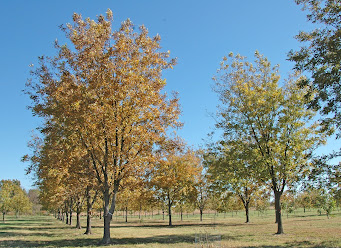On my farm, pecan harvest is a one man operation that involves my use of several types of pecan harvesting equipment. The first step in the process is to use a three-point-hitch mounted trunk shaker to dislodge to nuts from the tree (photo at left). To me, tree shaking is the most exciting part of pecan harvest. The sound of nuts raining down on the metal canopy of my tractor gives me an immediate idea of how well each tree has produced this year. Once the nuts are on the ground, I jump into different tractor that has a pecan harvester attached (photo at right). Sweeping nuts up off the ground with the harvester is a slow but steady process. I always start harvesting just outside the drip line of the tree then work my way inwards towards the trunk. My Savage harvester picks up nuts in a 5 foot swath so, on larger trees, it takes multiple passes to cover the ground. I've learned to be especially careful when maneuvering the picker near tree trunks. The front outside corner of the harvester can leave an ugly scar if you get too close.
Once the pecan harvester's hopper is full, I drive towards my barn to dump the hopper into a pre-cleaner. The pecan harvester picks up more than just pecans. When I dumped the hopper this year, I saw a mixture of nuts, stick-tights, shucks, sticks, and even acorns. Thankfully, I didn't pick up any mud balls this fall--soil conditions were ideal for harvest this fall. The pre-cleaner does a good job of removing sticks, shucks and leaves from the nuts. Next, I run the crop through a cleaner inside my pecan barn. The cleaner is good at removing poorly filled pecans and any nuts that were thinned off during mid-summer crop load adjustments. The final step in the cleaning process is to visually inspect every pecan as they move down an inspection belt. This year, acorns and green hulled nuts are the most common items thrown off the inspection table.
Back last spring, the 2020 crop year looked to be an outstanding year for Kanza. I had full crop of Kanza nuts and was excited to be able to reap the rewards of years of tree care. But like everything else this year, the unexpected can ruin the best laid plans. The summer of 2020 was extremely dry in our area. Corn fields withered and pecan trees suffered. The photo at left exemplifies what a lack of summer rainfall can do to a Kanza crop.Under drought conditions, Kanza nuts were almost 2/3 their normal size, while some nuts were even smaller. During harvest, I picked up numerous Kanza nuts still held inside green shucks. I cut open several green nuts (photo above) to reveal a total lack of normal kernel development. It is obvious to me--no water, no kernel development.



